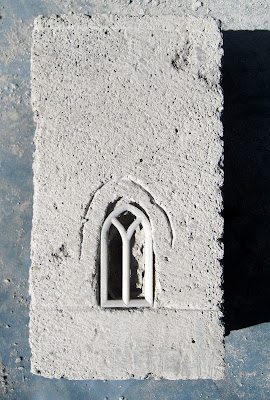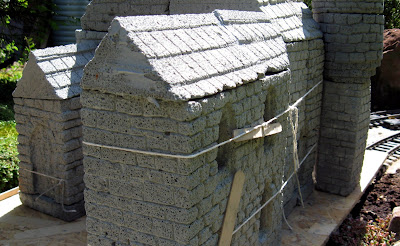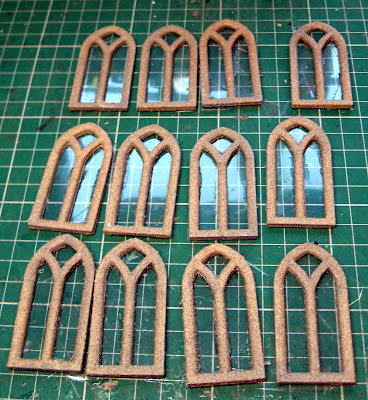However, running stock has been constructed, running sessions have been completed, visitors have been catered for, videos uploaded and some outdoor jobs completed.
Rolling stock
Hunslet - Hughie
Ever since I started with my garden railway, I have been intrigued by the 16mm scale card models produced by LocoLines - now produced by Rail-Road. After seeing an article in Garden Rail detailing how a modeller makes all his 16mm stock from card, I decided to give one of the Rail-Road card kits a try. In my previous Progress Report, I outlined construction of the basic kit - but since then I have enhanced the kit with a decent motor block, a new chimney, backhead detail, new springs and sandboxes and handrails and pipework.
The additional 3D printed detailing parts are available as free downloads on the Thingiverse.com website (registration required) and the GardenRails.org forum (registration required)
For more information see How I assembled a Rail-Road card kit
I am now in the process of producing a 3D printed version of a similar loco and am trying to decide whether to replace the card version or complement it.
GVT Glyn motor block
In my previous progress report I described how I had constructed a 3D printed model of a Glyn Valley Tramway Beyer Peacock tram loco. I was disappointed with the performance of the Bachmann motor block I had used to power it .....
..... and so designed and 3D printed a replacement using an MFA Como gearbox motor.
However, I was also disappointed with this motor block's performance and so have now designed and 3D printed a second replacement using a larger and more powerful gearbox motor.
This has much better performance.
For more information, see How I created my own motor blocks (pending)
Directors' Saloon
This has been on my To-do list for many years but, having now completed the gatehouse for Peckforton Castle (see below), I felt it was time to make this plan a reality. The saloon is based on one of the various designs of Glyn Valley Tramway four-wheeled coaches (see How I constructed a GVT coach).
For more information see How I designed, printed and constructed a Directors' Saloon
Permanent Way and Infrastructure
Sand Quarry Extension
The siding for the sand quarry installed in 2018 (see Progress Report 75), was always slightly short - primarily because the space for it was quite tight.
I toyed with a few ideas for extending it, but eventually opted to turn the siding through 90 degrees and turn it into a link back to the mainline just outside Peckforton station. This provided an opportunity for me to designate this new junction as a siding to serve Peckforton Castle (bottom left on this plan).
The extension has now been constructed and its track tested and ballasted.
For more information see How I built the sand quarry extension
Lineside
Peckforton Castle Gatehouse
With the completion of the sand quarry extension and its incorporated junction for Peckforton Castle, I decided the entrance to this new siding needed to be recognised with a new structure. The resultant gatehouse was based on the gatehouse for real vehicular entrance to the castle.
My model was carved from four Thermalite blocks.
Operation
Operating sessions
As indicated above, my first operating session of the year has been delayed slightly by a range of conflicting factors. However, one full session has been run plus a couple of smaller scale partial operating sessions
Visitors
In addition, the railway has hosted a visitation by Zach Bond and his mate Theo who spent an afternoon (and evening) running live steam and a range of other scheduled and unscheduled train services.
Freight management Mk V
Over the years, I have produced four versions of my computerised freight management system:
- Mk I - based on the 4D relational database
- Mk II - based on LiveCode ( a derivative of Apple's HyperCard)
- Mk III - based on Psion's OPL
- Mk IV - based on Google Sheets
More figure scanning
Following Dean's (from DesignScanPrint3d) previous visit to 3D scan members of our local dramatic society in 1930s and 1940s costume - see Progress Report 95
he paid us another visit to scan more figures, this time with more specific poses. I have now received the first batch of figures from him.
As you can see, these figures are more engaged in activities, rather than static poses. There will also be some seated figures to become passengers in my rake of recently finished GVT coaches (see Progress Report 95)
Other developments
Year long video
I am steadily working my way through my schedule to record the next monthly instalment of the Year Long Journey videos - depicting a mixed train travelling Down and back up the line in twelve monthly stages.
June's Down sequence sees the train arriving at Peckforton and having some wagons shunted off and on by Doris, the timber yard's shunter.
While the Up shot is of the train passing the water mill on the approach to Peckforton.
By September the train will have completed its two journeys and I will be able to compile the two videos.
3D printer repairs
3D printers require a certain amount of nurturing to keep functioning successfully. My budget (£70) Anet A8 printer developed a fault which required the replacement of the heated bed.
Sometimes, it takes longer to track down the source of the fault than it does to repair it.
So, all in all, it has been quite a productive period since my last progress report. Despite not having had time to engage in more than one operating session, there have been plenty of other jobs to keep me actively involved. As the summer progresses, I aim to run quite a few more trains.
<< Previous Progress Report - Next Progress Report >>






























































































